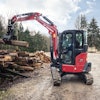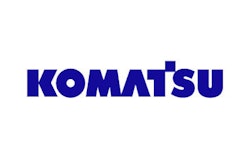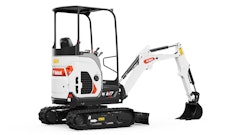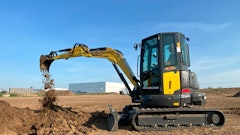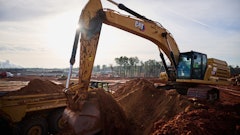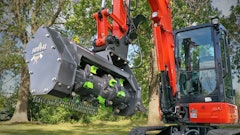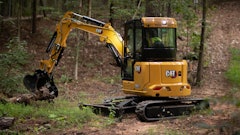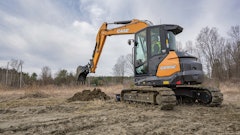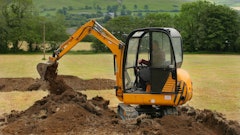
Looking to increase your company's efficiency and profits? A compact excavator could help. These useful machines, weighing up to about 15,000 lbs., can replace several workers and help complete many jobs faster.
What a compact excavator can do
The compact excavator, or mini hydraulic excavator (MHE), is a versatile machine that can handle many tasks. "The compact excavator is what I call a Swiss Army knife," says Matthew Hendry, product consultant for hydraulic excavators and ADT at John Deere. "With the addition of a manual or hydraulic coupler, it can change work tools very easily. This lets it do nearly any task you can put before it. You're limited by imagination rather than by what the machine will do."
The compact excavator is a good machine for jobs requiring travel across different surfaces and jobs where work must be done close to obstacles or where access is tightly restricted, says Darren Wilson, mini hydraulic excavator industry marketing manager at Caterpillar Inc. Typical tasks include excavation, grading, truck loading, compaction, and both breaking and loading for concrete removal.
"Compact excavators are well suited to a variety of job requirements, like site prep, foundation and footers, utility work (electrical and plumbing), craning (septic tanks or junction boxes), demolition, and landscaping, and especially for working where space is limited," notes David Caldwell, product marketing manager at Komatsu.
"Flatwork contractors doing residential work can save on labor by using it to pick up broken concrete instead of having workers do it," Hendry says. This will prevent workers from developing back problems and could reduce health insurance costs. "Most laborers on a concrete crew are the same ones who will do the finish work," he adds. "Why risk them to injury when you can do it much more efficiently with a hydraulic compact excavator? The compact excavator is just plain faster than humans can move and it doesn't need a break."
What makes compact excavators particularly useful for concrete contractors is their independent boom swing and 360-degree house slew. "Combined, these features allow the operator to excavate parallel to existing structures and afford the operator the utmost flexibility for spoil placement," says Tom Connor, excavator product specialist at Bobcat Company. "The operator can excavate in front of the machine, then slew and place the spoil behind or on either side of the excavator."
Most companies offer models with zero house swing and/or zero or reduced tail swing, enabling operators to work near buildings and other objects with less risk of hitting anything when the house turns.
These small machines do well in space-restricted jobsites. For example, Komatsu's smallest compact excavator weighs only 1,985 lbs. and has a retractable undercarriage so it can pass through gates and doorways. It is light enough to ride on freight elevators for inside demolition jobs. When working in confined areas, the maneuverability and agility of a compact excavator enhances the operator's ability to get in, do the job, and get out much more quickly than larger equipment.
"The machine's smooth hydraulics give it the ability to cut precise holes and shapes," says Wilson. "MHEs can load trucks more easily than most machines, so load and carry can be eliminated by bringing the truck closer to the machine. MHEs can dig and spin 180 degrees to load a truck on the other side, so even tight spaces cannot hamper productivity."
Attachments get work done
An array of attachments are available for compact excavators. The most popular are trenching and grading buckets and hydraulic clamps or thumbs used to grasp, pick up, sort and place material. Also available are augers, hydraulic breakers, vibratory plate and roller compactors, ripper teeth, shears, rotating clam-shells, hammers, grapples and rakes.
Attachments designed for skid steers may not work with compact excavators. Contractors who own skid-steer attachments should ask whether they are compatible while evaluating a compact excavator purchase. Compact excavator attachments made by one company may connect with machines made by another manufacturer, although some companies use proprietary attachment methods that limit the use of their attachments to their own machines.
Operator considerations
Compact excavators usually have rollover protected structures (ROPS) for operator safety. Some have covered open canopies, while others feature heated and air-conditioned cabs. Leg room can be limited. Joystick controls are designed for ease of use. Other safety features may include retractable seat belts, neutral start and automatic swing break systems to avoid unintended movement, and travel alarms that sound when the machine moves.
There is a learning curve for new operators. "Someone who operates a skid steer well will take a couple of days to learn the basics and a few months to become proficient," Hendry notes. "Learning to be accurate with a compact excavator is not something that happens overnight."
He says videogamers pick up the basics quickly because of their joystick experience.
Necessary maintenance
Daily inspections of the compact excavator's oil, air filter and coolant should be made. Oil and filters should be changed and the machine greased at the interval specified by the manufacturer, which is between 100 and 500 hours of operation. While most routine maintenance can be done by the contractor, Wilson encourages contractors to buy service contracts for these machines.
Before selecting a compact excavator, Hendry recommends finding out whether there is a local dealer, whether that dealer keeps parts in stock and how quickly they can provide mechanics if the machine breaks down. He estimates a well maintained compact excavator will provide 5,000 hours of service before needing major repairs.
Rent or purchase?
Compact excavators run from about $21,000 to about $105,000, depending on weight, features and options. Determining how quickly this investment will pay for itself is based on how much the machine is used. "If this contractor is renting a compact excavator three or more times a month, it's time to consider buying," says Hendry. He estimates the payback period at three to five years.
"Many contractors will tell you that the driving factor for them is having a machine available instead of trying to rent one on a regular basis," Connor points out. "Oftentimes compact excavators are among the most popular pieces of equipment at a rental store or a dealer's rental fleet. It can be challenging to find the right machine with the appropriate dig depth and dimensions to match the jobsite conditions." He also suggests investigating attachment availability before buying to maximize machine utilization.
"There are many variables that determine a contractor's decision to rent or purchase a compact excavator - type of business, amount of business, number of employees and investment capital are just a few," says Caldwell. He says contractors should ask themselves whether their need is long term, short term, or permanent, look at the benefits of both renting and owning, and then compare the monthly payments in light of today's low interest rates. Contractors might also consider trying a rental purchase program which lets them operate the machine and determine if it meets their job requirements before buying.
When bigger is better
But compact excavators can't do everything a concrete contractor might need to do. "There are large-scale demolition jobs that would require large hydraulic excavators with specialized attachments," Caldwell points out. The dig depth required may also exceed the compact excavator's specifications.
"Contractors working in wide-open areas with high volumes of excavating and trenching projects may be better suited with a full-size excavator," Connor agrees. Hendry says compact excavators can't dig extremely hard material, like rock. However, they can still be useful for small odd jobs on large projects, like digging small trenches.
The machine for today?
"The North American market for compact excavators has grown substantially in recent years," notes Caldwell. "From the year 2000 to 2005, the compact excavator market grew nearly 300 percent. The versatility of the compact excavator is making them the machine of choice for contractors in many different fields."
"The MHE industry is on a torrid pace of growth," Wilson agrees. "Rental and retail numbers are way up year over year. The machine provides good value, good resale and appropriate returns as a tool for concrete contractors."
"Most concrete contractors have skid steers already," Hendry says. "This is the next machine they will buy. These will save concrete contractors so much money and they don't call in sick."
Jean Feingold is a Gainesville, Fla.-based freelance writer who frequently covers concrete and other construction-related topics.
| Transporting a compact excavator Contractors should check their local Department of Motor Vehicle regulations to determine the truck and trailer combination required to transport the compact excavator securely. Some states may require the driver to have a commercial driver’s license, so contractors should check local licensing laws before operating any truck or trailer, notes Tom Connor, excavator product specialist at Bobcat Company. Compact excavators weighing up to 10,000 lbs. can be taken to the jobsite using a pickup truck and a gooseneck trailer. “Small machines can be towed behind a standard 3/4-ton truck and therefore it can travel with the crew as opposed to separate machine delivery,” Wilson points out. “This translates to less downtime for the crew waiting for machines to arrive. In most areas this distinction allows the contractor to move machines without the need for a commercial driver’s license.” Larger machines require a class 5, 6 or 7 truck and a tag trailer or gooseneck trailer 20 tons or less. Contractors will need sufficient trailer and truck capacity to haul a skid steer or compact track loader and the compact excavator and bucket at same time, Hendry notes. |



